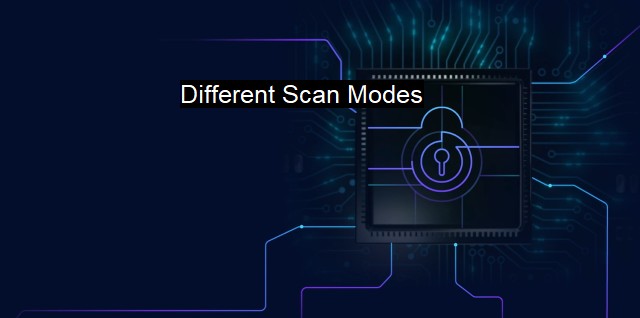What are Different Scan Modes?
Exploring Antivirus Software Scan Modes: An In-Depth Look at Ensuring Digital Security
The method an antivirus software uses to identify and neutralize security threats varies depending upon the mode of scan chosen. Different scan modes offer varied degrees of thoroughness, operations speed, and system resources utilization, striking diverse balances between security and system performance. Given the various cybersecurity threats and complex cyber attack funnel stages, these differing scan modes enhance particular aspects of an antivirus software's detection and problem resolution capabilities.Full Scan is one of the most frequently performed antivirus scan modes due to its thorough nature. This comprehensive approach phases through every single file, application, and piece of executable code contained on the user's system, including those hidden in compressed and packaged files and even those files not presently in operation. Early malware, high-grade exploits, rootkits, and Trojan horses often reside in rarely touched system back-ends and are meticulously searched out by a Full Scan. Such a comprehensive methodology requires significant amounts of time and system resources, often leading to reduced system performance during its operation.
On the contrary, Quick Scan mode focuses on identifiable regions where malware often infiltrates, such as the system memory, auto-start applications, and specifically defined potentially vulnerable locations. This makes this scan—with its inherently limited sweep—a rapid detection mechanism particularly effective against commonly encountered threats. Thus, despite its limited outlook, the Quick Scan's lower system load and time-efficiency make it a popular choice for regular use.
Custom Scan is an interactive method that grants the user flexibility to pick and choose the individual files, folders, or drives that need to be scanned. Depending upon the users' understanding of their systems and threat perception, this mode can act as either a full scan or a quick scan. It harnesses the users' knowledge and intuition about their system's structure and vulnerabilities, allowing an exhaustive scouring of the suspected sectors or just a quick sweep for peace of mind without overburdening the system resources.
Heuristic Scan mode, sophisticated yet experimental, goes beyond the traditional ways an antivirus operates. Where standard antivirus scan modes look for an exact match of malicious codes or compare the patterns to known threats, Heuristic Scanning aims to unearth unknown or emerging threats via its dynamic outlook. It scrutinizes files for still-unclassified suspicious activities, patterns, anomalies, or codes potentially capable of unauthorized control or data manipulation. This relatively less common scan mode, based on predictive algorithms, exhibits a broader safety net for Netizens in terms of preemptive malware detection. Although not 100% accurate, it is critical for staying at least one step ahead of the cyber-criminals.
With the increasing complexity and dynamism in threats encountering today's digital age, specialized scans named as Rootkit Scan, Boot Scan, and Removable Media Scan have also been introduced. Rootkit Scans aim to detect powerful threats that deep-seat inside system segments, stealthily performing harmful operations. Boot Scan operates during the system boot process before any malware has been given the chance to activate, thus, often outmaneuvering any threat attempting to remain disguised in the packed files during regular operations. Removable Media Scan focuses on secondary storage options linked to the system to protect against any potentially compromising code moving in or out via these pathways.
Different scan modes paint an increasingly clearer and detailed picture of the system's overall health and threat potential. Offering flexibility in terms of time, system demand, and detection intricacy, these modes serve as defence layers that screen out various types and scales of threats. Therefore, appropriately utilizing these diverse scanning defense systems is a crucial aspect of maintaining robust cybersecurity.

Different Scan Modes FAQs
What is a full scan mode and when should I use it?
A full scan mode is a comprehensive scan that checks all files and folders on your computer for viruses and malware. It is a good idea to use a full scan mode if you suspect that your computer may be infected with a virus or if you haven't run a scan in a while.What is a quick scan mode and when should I use it?
A quick scan mode is a faster scan that checks only the most common areas where viruses and malware are known to hide. It is a good idea to use a quick scan mode if you want to quickly check your computer for any potential threats.What is a custom scan mode and when should I use it?
A custom scan mode allows you to select specific files or folders to scan for viruses and malware. It is a good idea to use a custom scan mode if you know which files or folders may have been compromised, or if you want to scan particular files or folders that are not included in a full or quick scan mode.What is a scheduled scan mode and when should I use it?
A scheduled scan mode allows you to set up automatic scans at specified intervals. It is a good idea to use a scheduled scan mode if you want to ensure that your computer is regularly scanned for viruses and malware without having to manually initiate the scan each time.| | A | | | B | | | C | | | D | | | E | | | F | | | G | | | H | | | I | | | J | | | K | | | L | | | M | |
| | N | | | O | | | P | | | Q | | | R | | | S | | | T | | | U | | | V | | | W | | | X | | | Y | | | Z | |
| | 1 | | | 2 | | | 3 | | | 4 | | | 7 | | | 8 | | |||||||